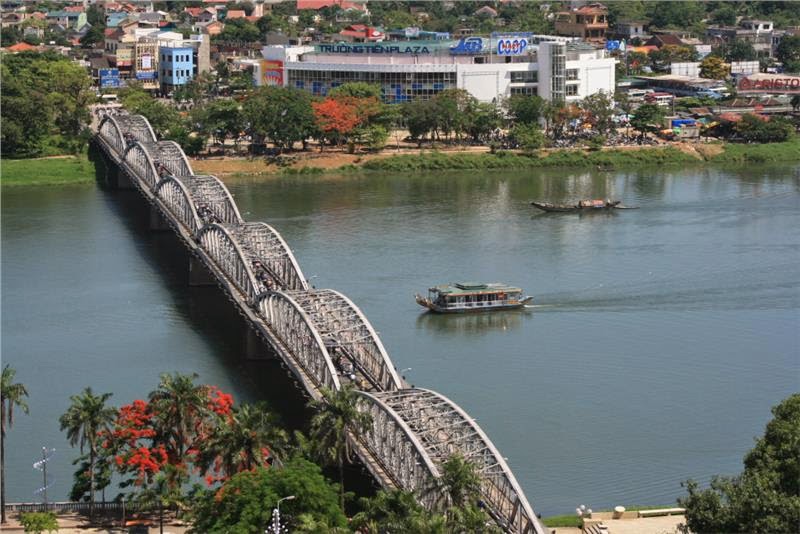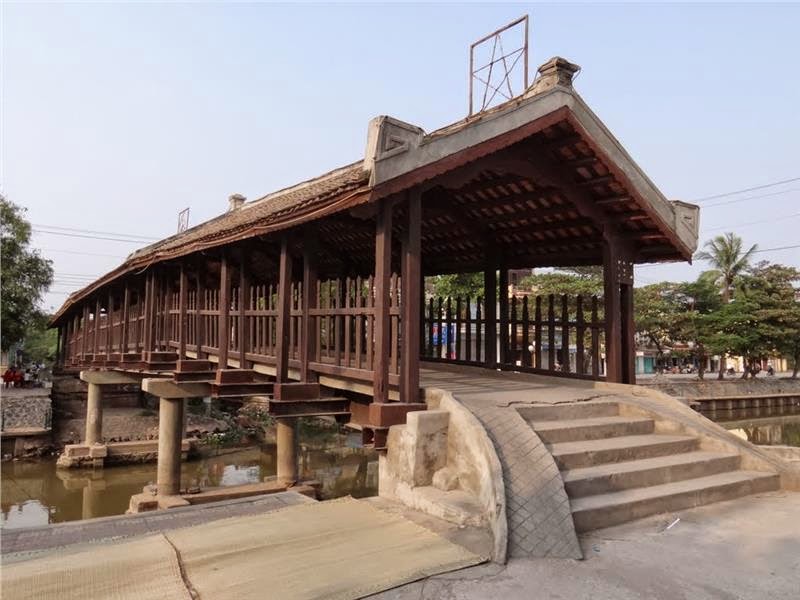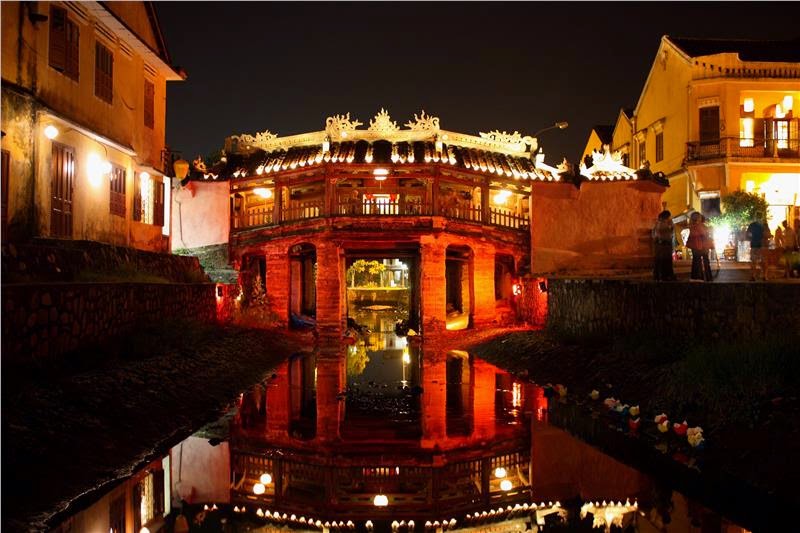Nhat Tan Bridge
 |
| Nhat Tan bridge |
Nhat Tan Bridge is the biggest cable-stayed bridge in Vietnam. The project of Nhat Tan Bridge in Hanoi has a length of 8.3 kilometer long. The bridge section of Nhat Tan Bridge is 3.7 km, including the main bridge spanning Red River is 1.5 km long. It is the cable-stayed bridge with constant spans and 5 pillars. Each span has 11 couples of staycabled to support the capacity of the bridge. With high requirements of technique and fine art, Nhat Tan Bridge is designed and constructed to become a new symbol of Hanoi capital. Five span towers symbolize five entrances to enter the inner city. Being built from 2009, Nhat Tan Bridge was inaugurated on January 4th, 2015. The bridge has a total investment capital of 14,000 billion dong. It took 6 years to complete the construction. The bridge connects the city and Noi Bai International Airport and Flamingo Dai Lai Resort – one of the best the resorts in the world. The advent of Nhat Tan Bridge is the symbol of Vietnam and Japan friendship, as well as creates favorable conditions for tourists of Vietnam tour packages in Hanoi.
Long Bien Bridge
 |
| Railway in Long Bien Bridge |
Long Bien Bridge is the first steel bridge spanning over Red River in Hanoi. Long Bien Bridge is not simply built to serve the local transportation, but also a long-lasting historical witness. Undergoing the damage of time and war, the bridge has existed heroically along with the development and modernism of the capital. Long Bien Bridge links Hoan Kiem District and Long Bien District of Hanoi City. The bridge was built by the French (1898-1902). Initially, the bridge was named after the name of General Governor of Indochina, Paul Doumer. Later, it was renamed Long Bien Bridge. The bridge is 2290 meter long with a central single railway. To construct the bridge, it wasted 3000 native workers, 40 French managers, engineers, experts, and foreman. The total cost of the bridge was 6.2 million franc. Long Bien Bridge is over 100 years old. It owns many historical values of Hanoi in particular and Vietnam in general.
Bai Chay Bridge
 |
| Bai Chay Bridge |
Located in Quang Ninh province, Bai Chay Bridge is the first flat cable-stayed bridge in Vietnam. The bridge is located on National Road No.18 with a length of 903m and a width of 25.3m. The bridge connects Hon Gai and Bai Chay. The bridge spans over Cua Luc channel, separating Cua Luc Bay and Halong Bay. This bridge is the first cable-stayed structure with a flat surface of Vietnam. At the same time, Bai Chay Bridge also sets a world record in the main span length (435m). The bridge was designed and constructed by Japanese contractors.
Truong Tien Bridge
 |
| Truong Tien Bridge |
Truong Tien Bridge is the first bridge spanning Perfume River in Hue. Like Long Bien Bridge across the Red River in Hanoi, Truong Tien Bridge is the first bridge across the river in Hue, near Hue Citadel. Truong Tien Bridge is also one of first bridges constructed in Indochina in late XIX and early XX centuries with new and modern technique and materials from Western countries. The total length of Truong Tien Bridge is 402.60 meters, designed in Gothic architectural style. Images of spans arching reflected into Perfume River, girls in white and violet Ao Dai, boats on the river under the bridge with beautiful melody and words of eternal romantic poem, red phoenix flowers, or the shimmering bright image the bridge at night are beautiful memories in mind of tourists on Vietnam holidays in Hue.
Dragon Bridge
 |
| Dragon Bridge |
Dragon Bridge in Da Nang is one of Vietnam bridges owning most awards. Dragon Bridge is the 6th bridge spanning over Han River. It was inaugurated on March 29th, 2013. The bridge has a length of 666m with six lanes. The total investment capital is 1,700 billion VND. Dragon Bridge is one of the most highlights in Vietnam tours to Da Nang. Dragon Bridge was proposed to the World Record Guinness for being "the longest steel dragon". Dragon Bridge gained international FX Design Awards 2013 and Lighting Design Awards 2014 for being one of world excellent lighting design works. At the award ceremony of Excellence Engineering Excellence Award (EEA) in the US, Vietnam Dragon Bridge was named for Grand Award, along with 7 works and projects of the United States and other countries. Unlike other bridges in the world, Dragon Bridge with unique design facsimiles the shape of a dragon curving above Han River towards the South China Sea. Dragon Bridge emerges on prominently with brilliant yellow color. The dragon's head highly heads straight out to sea, as affirming the image of the dynamic city and taking the image of Da Nang City across the world... Being regarded as the symbol of the worthiest city to live in Vietnam, Dragon Bridge is an outstanding venue to organize important events of the city, Vietnam and region. Also, it is indispensable attraction in Da Nang travel.
Han River Bridge
 |
| Han River Bridge |
Han River Bridge in Da Nang is the first swing bridge in Vietnam. The bridge was contructed from 1998 to 2000. It was designed and built by Vietnamese architects and workers, and it is the only swing bridge in the country. Han River Bridge connects two main boulervards of Da Nang City (Le Duan Street in the west and Pham Van Dong Street in the east. Han River Bridge is 487.7 meter long. Everyday, at 1 a.m the bridge will turn 90 degrees to let big ships easily travel. At about 4 a.m, the bridge will return. Han River Bridge and other famous bridges in Da Nang become top attractions in Da Nang City. Along Marble Mountains, Han River Bridge is a sacred symbol of the city with meaningful beauty.
Thuan Phuoc Bridge
 |
| Thuan Phuoc Bridge |
Thuan Phuoc Bridge is the most modern and longest suspension bridge in Vietnam. The bridge has a total length of 1,850 meters, linking two banks of bays in Da Nang. Bridges are among the most highlights in Da Nang City. They not just create favorable conditions for local people to travel, but also for the city’s development, and creating unmatched beauty in the city with unique architectural ideals. Thuan Phuoc Bridge from all sides brings a sense of modernism, charm, and marvelousness. The bridge is located in a prime position, which facilitates to develop Vietnam tourism potentials in Da Nang and other neighboring localities.
Phu My Bridge
 |
| Phu My Bridge |
Phu My Bridge is the biggest cable-stayed bridge in Saigon. As being the largest cable-stayed bridge in Ho Chi Minh City spanning Saigon River connecting District 2 and District 7, with the total investment capital of 2076 billion dong, Phu My Bridge was inaugurated to build on September 9th, 2005 and completed in 2009. Phu My Bridge is not just a key project of Vietnam, but also the most modern cable stayed bridge in the world. The most modern part of the bridge is the technique of cable stayed. Few bridges in the world own the technique. These above bridges in Vietnam are not just symbolizing the development and face of each locality, but also possessing meaningful cultural and historical values.


